Hille, Germany
![]()
The title of this article is ambiguous. For other meanings, see Hille (disambiguation).
Hille [![]()
![]() ˈhɪl̩ə] is a municipality in the district of Minden-Lübbecke in the north of East Westphalia with about 16,000 inhabitants. It was formed in 1973 as part of the municipal reorganization of North Rhine-Westphalia by the merger of nine municipalities of the Mindener Land. It is named after the village of Hille.
ˈhɪl̩ə] is a municipality in the district of Minden-Lübbecke in the north of East Westphalia with about 16,000 inhabitants. It was formed in 1973 as part of the municipal reorganization of North Rhine-Westphalia by the merger of nine municipalities of the Mindener Land. It is named after the village of Hille.
The area of the municipality is 102.99 km² and includes the lowlands of the North German Plain with the lowest point at an altitude of 45.7 m as well as the part rising to the Wiehengebirge mountains at the southern edge with an altitude of up to 261 metres.
During the Holy Roman Empire, the area of the municipality belonged to the bishopric of Minden and was shaped by the lords there. In 1648 the bishopric was secularized and fell to Brandenburg-Prussia under the name "Principality of Minden".
At the beginning of the 20th century Hille was connected to the Mindener Kreisbahnen, a little later, 1911-1915, the Mittellandkanal was dug through the marshy landscape in front of the Wiehengebirge and a harbour was established in Hille. After the Second World War many refugees settled here, the population increased noticeably.
The economy is still heavily dominated by agriculture, but there are now a variety of industrial and artisanal production, trade and service enterprises.
Geography
Geographical position
Hille is located in the north-east of the federal state of North Rhine-Westphalia and on the northern border of the administrative district of Detmold. Situated in the centre of the Mindener Land, the municipality's northern border borders on the neighbouring federal state of Lower Saxony. Large parts of the municipal area belong to the North German Plain.
Hille is part of the natural areas Wiehengebirge, Lübbecker Lößland, Bastau Niederung and Rahden-Diepenauer Geest. The southern part, the Rothenuffelner Lößhang, is located in the transition zone from the North German Plain to the low mountain range landscape. The ridge-like structure of the Wiehengebirge closes off the municipality of Hille from the Ravensberg Hills to the south.
The main part of the municipality is already part of the lowland, which gets its special character from the end moraine landscape formed in the Saale ice age. In the area of the Endsander moors could form, which are drained towards the Weser. Their remaining area is today called the Great Peat Bog. In earlier times, the moor continued eastwards as far as the Minden area. Centuries of peat cutting led to the transformation into the Bastauwiesen, an important wetland biotope designated as a nature reserve since 1980.
Two rivers divide the area: The water from the northern slope of the Wiehengebirge is collected by the Bastau, which drains the area to the east and flows into the Weser near Minden. The Ösper, which rises in the northern part of Hille, flows to the northeast and flows into the Weser near Petershagen.
The municipality of Hille is crossed in the northern part of the Basta lowland by the Mittelland Canal running from east to west. The adjacent Hartumer Lößplatte to the north is more densely populated and intensively used for agriculture. In the very north of the municipality, in the border area to the town of Petershagen, lies the nature reserve Mindener Wald, a state forest that was long owned by the diocese of Minden.
In the west, this landscape formed by the Ice Age continues into the Osnabrücker Land. The loose agricultural landscape is characterised by a network of scattered settlements and individual farms, which are structured by farmyards and hedges. On the heights of the Wiehengebirge as well as in the north there are forests, in lowlands and on marshy soils there are meadows.
Geology
The municipal area is mainly shaped by the periglacial and postglacial overformation processes during and after the Saale glaciation. When the area was still covered by ice, the water had a predominantly southward flow direction, opposite to the present drainage direction. It collected in a river landscape to the north of the Wiehengebirge, and then flowed westwards towards the sea. Extensive moors developed in this primeval valley, which for a long time were difficult for people to cross.
With the exception of a few unsuitable locations, Hille is moderately to well suited for the use of geothermal heat sources by means of geothermal probes and heat recovery by heat pump heating systems (cf. the adjacent map).
Floor
Due to the above-mentioned glacial conditions, different fertile soil can be found in the municipality of Hille, with different effects on the settlement structure. For example, in the south, in the region between the Wiehengebirge and the Bastauniederung, there is fertile soil on high lying areas, also known as the Lübbecker Lößland. Here the settlements Rothenuffeln, the two villages Oberlübbe and Unterlübbe as well as Eickhorst have formed. To the north of this area is the swampy Basta lowland, where no significant agriculture can be practiced. For this reason, the line of the Mittelland Canal runs along the northern part of the moorland areas that lie in front of the Wiehengebirge. Here the ground is level. Northeast of it the Hartumer loess plate is connected, where good arable farming possibilities prevail. Therefore the villages Hartum, Nord- and Südhemmern and Holzhausen II are located here. The farms in the villages are medium-sized, agricultural farm sizes of 100 acres are not uncommon. This loess area continues in the west behind the river Flöthe, here the village Hille is the centre of settlement activity. In the northeast of the municipality of Hille, poor soil is found around Wittloge, the cultivation there only allows for forest cultivation (Mindener Wald).
Fauna
The white stork can be found in the area of the municipality of Hille, the reintroduction and maintenance of the population is supported.
Extent and use of the municipality
The municipality of Hille, classified as a "large rural municipality", lies in the North German Plain, rising to the ridge of the Wiehengebirge in the south. There, the highest point is the Haddenhauser Berg in the village of Rothenuffeln with 261 m above sea level, in the lowlands the lowest point is in the moor near the village of Hartum with 47.7 m above sea level. From east to west Hille stretches over 11.8 km, from north to south over 15.4 km.
|
| Agricultural land | Forest area | Building, | Traffic area | Water surface | Sports and green area | otheruse |
| Area in km² | 76,05 | 7,76 | 8,82 | 6,31 | 2,25 | 0,65 | 1,15 |
| Percentage of total area | 73,84 % | 7,53 % | 8,56 % | 6,13 % | 2,18 % | 0,63 % | 1,12 % |
Neighbouring municipalities
Hille is located in the centre of the district of Minden-Lübbecke in the north-eastern border area of the state of North Rhine-Westphalia with Lower Saxony. Except for the state border in the north, Hille is therefore surrounded by municipalities of this district. In detail, these are the historically formative, old episcopal and district town of Minden in the east, to the northeast is Petershagen, in the north is the Lower Saxonian joint municipality of Uchte. To the west of Hille are the town of Espelkamp and the former district town of Lübbecke, and to the south behind the Wiehengebirge mountains in the Ravensberg hills are the municipality of Hüllhorst and the town of Bad Oeynhausen.
Historically, the area is still oriented towards the old district towns of Minden and Lübbecke; this does not apply to the towns of Espelkamp and Petershagen, which were also created as part of the municipal reorganisation.
Community structure
According to § 3 para. 1 of its main statutes, the municipality of Hille is divided into the following nine localities, which were independent municipalities before 1973 and belonged to the dissolved offices of Dützen and Hartum:
- Eickhorst
- Hartum
- Hille
- Holzhausen II
- North Hemmern
- Oberlübbe
- Rothenuffeln
- South Hemmern
- Unterlübbe
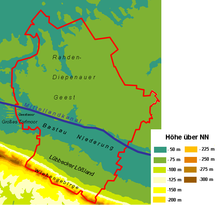
The topography of the municipality of Hille
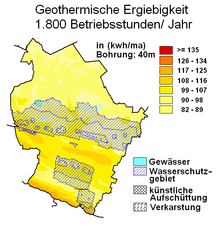
Geothermal map of Hille

Local parts of the municipality of Hille
History
Hille has been shaped by its agricultural structure up to the present day. In addition to the large farms, which arose due to the fertile loess soil, especially on the Hartum loess plateau, there were until the 19th century, many small haymakers, whose owners earned extra money through craft work such as the linen weaving and cigar making, which emerged in the 19th century in Hille. Especially in the 19th century many people emigrated from today's parts of Hille to the USA. The destination was often New York and here in the wider area Schenectady. Other Hiller went as so-called Hollandgänger on foot up to the Netherlands, in order to mow grass there. There, too, some Hillers stayed forever.
In the middle of the 19th century, the infrastructure was expanded by a large road building program of the Minden district administrator Carl von Schlotheim. This was also to be seen as a job creation measure, which helped the district to an economic upswing.
In the early 20th century the railway reached this rural region. In 1903 the Mindener Kreisbahnen opened a narrow-gauge line from Minden to Eickhorst. In 1907 this narrow-gauge railway was extended to Lübbecke. The railway was later converted to standard gauge. The task of this Prussian branch line as a melioration railway was to open up the agricultural areas: Delivery of artificial fertilizer, removal of agricultural products to the district towns of Minden and Lübbecke and from there via the existing state railways there to other towns. The construction of the Mindener Kreisbahnen was also a well-organised job creation scheme, thousands of workers received wages and bread during the construction of the line. The section Lübbecke-Hille was closed down in 1967 and subsequently dismantled. Between Hille (port) and Minden freight traffic still takes place today. Oberlübbe also had a connection to a small railway from 1897 to 1937. The "Wallücker Willem" connected the quarry near Wallücke in the Wiehengebirge to the south with Löhne and Kirchlengern and carried not only iron ore but also passengers.
For a long time, almost all Hillers spoke Platt, which may well show greater differences from one part of the community to another. Nowadays the use of this language is strongly declining.
Religions
All villages of the municipality of Hille became Evangelical Lutheran like the city of Minden in 1550 with the introduction of the Reformation. Accordingly, the parishes are laid out until today. When the area fell to Prussia, the regional church was united to form the Evangelical Church of Westphalia, which later developed into the Uniate Church, i.e. uniting the Lutheran and Reformed denominations. In the meantime, the church congregations have partially merged; one congregation covers the area of several villages. Some of the old church buildings have been given up and replaced by new buildings, e.g. the old vicarage in Hille.
By taking in the refugees of the Second World War, Catholic parishes were founded, which slowly changed the religious landscape towards multi-faith. The only Catholic church of the parish is located in the centre of the village (Brennhorster Straße) and belongs today to the pastoral association Mindener Land.
Incorporations
The large municipality of Hille was created on 1 January 1973 in the course of the implementation of the Bielefeld Act as part of the North Rhine-Westphalian municipal reform. In the process, the previously independent municipalities of Eickhorst, Hartum, Hille, Holzhausen II, Nordhemmern and Südhemmern from the Hartum office and Oberlübbe, Rothenuffeln and Unterlübbe from the Dützen office in the former district of Minden were merged. In the eastern peripheral areas parts of the municipalities Hartum and Holzhausen II were given to the city of Minden, in return some parcels of the municipality Hahlen were incorporated into the municipality Hille. The offices Hartum and Dützen were dissolved; the municipality Hille is the legal successor of the office Hartum. The old Amtshaus Hartum, which is very decentrally located in the newly formed municipality, was designated as the town hall.
Population development
The following overview shows the population figures of the municipality of Hille according to the respective territorial status. The figures up to 1970 and for 1987 are census results and from 1975 onwards official updates from the State Statistical Office. The figures for 1975, 1980 and 1985 are estimated values, the figures from 1990 onwards are updates based on the results of the 1987 census. Until 1985 the figures refer to the resident population and from 1987 onwards to the population at the place of the main residence.
Hille according to the territorial status at that time
| Year | Inhabitants |
| 1961 (June 6) | 3.755 |
| 1970 (May 27) | 3.815 |
| 1972 (Dec. 31) | 3.767 |
Hille according to the present territorial status
|
|
|
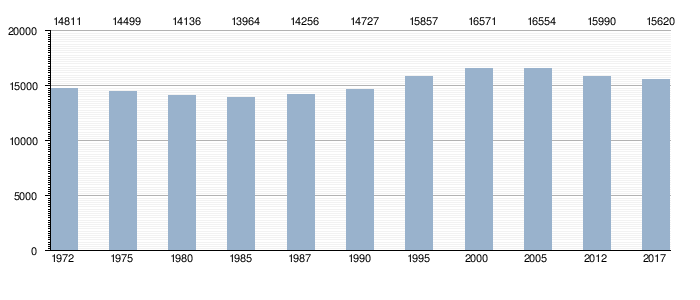
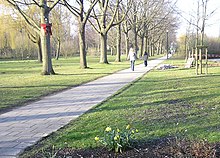
Spa park in Rothenuffeln
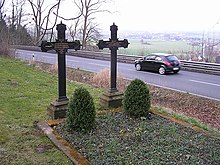
Grave of Carl von Schlotheim at the pass of Bergkirchen, road builder

Old vicarage in Hille village
Search within the encyclopedia